- Home
- Larry McMurtry
Oh What a Slaughter Page 10
Oh What a Slaughter Read online
Page 10
After Custer the whites made a great outcry for vengeance, but it was not easy to find Indians to wreak vengeance on. Buffalo Bill, by then a showman, rushed back west and took what he claimed was the first scalp for Custer, that of the Cheyenne warrior Hay-o-wei, or Yellow Hair. Whether or not Cody actually killed Hay-o-wei is not absolutely clear, but he did take the man’s scalp, which he sent to his estranged wife as a trophy, hoping it would somehow mollify her. Understanding of the ways of the female heart was not one of Cody’s strengths.
General Crook, the gray fox, with a huge contingent of some four thousand men, lumbered around the northern prairies for a while, finding no one to fight. General Miles chased Sitting Bull to Canada but had to let him go. In the dreadful winter of 1876–1877 Crook did hit a Cheyenne village, on a night so cold that eleven babies froze to death.
General Miles switched his attention to Crazy Horse and harassed him into the depths of the winter, but didn’t catch him. In the spring Crazy Horse concluded that, for a time at least, the game was up. He came in, with nine hundred people and a lot of horses.
Not long after the army disarmed Crazy Horse, the Nez Percé roared out of Idaho into Montana and made for Canada, mopping up everyone who got in their way. The army, horrified by this unexpected outbreak, seems to have briefly concluded that Crazy Horse might be the only man who could stop them. Bizarrely, as it must have seemed to him, they offered to arm him again if he would go fight the Nez Percé. The offer must have confused him—if he understood it. Puzzled, perhaps, he may have said okay, he would go fight the fugitives until every last Nez Percé was killed. The interpreter at this council, Frank Grouard, who knew Crazy Horse and may have been jealous of him, apparently told the white officers that Crazy Horse had intended to fight until every last white man was dead. Some of the listeners who understood Sioux were horrified; they tried to persuade the officers that Crazy Horse hadn’t said anything of the sort, but a dark doubt had been planted in the officers’ minds, the fruit of which was the decision made by General Crook to arrest Crazy Horse at once and have him shipped to the Dry Tortugas, to the dreadful prison for incorrigibles.
As is well known, when an effort was made to arrest him, Crazy Horse resisted and was bayoneted by a white soldier, while Little Big Man—once his friend, now an Indian policeman—held his arms.
Crazy Horse died in 1877. The years between his death and 1890 were sad and unheroic times for the native peoples. As it was in Arizona, so it was in Wyoming, Nebraska, and the Dakotas. The government was constantly trying to position these defeated, demoralized people in places where they would do the least harm; this meant, in most cases, allocating them the worst land—even though what at first seemed the worst land soon enough turned out to be land that the whites thought they might just have a use for after all. Few places in the whole West turned out to be so bleak that the whites wouldn’t eventually want it.
There was little happiness among these reservationed peoples. There were a few decent, honest Indian agents, but there were many more who were corrupt, interested only in greasing their own palms at their wards’ expense. J. P. Dunn rightly excoriated this all too numerous breed.
Then, in the 1880s, out of the desert places, there arose a prophet, a messiah of sorts, who soon began to attract a following; he preached a message of Renewal and Return, to be achieved through a dance ritual that came to be known as the Ghost Dance, since one of its purposes was to have the dead rise up.
This prophet was a short, stocky Paiute named Wovoka—though when he lived with a white family, as he often did, he introduced himself as Jack Wilson. Wovoka, or Jack Wilson, lived into the 1930s—he may even have appeared in a silent movie.
The doctrine he preached—mildly, it should be said—the doctrine of a Return, common to many preachers of various faiths, nonetheless set the stage for the final conflict at Wounded Knee Creek.
Why it should have been thus is a complicated story.
Wounded Knee,
December 29, 1890
The anthropologist James Mooney, the author of what is still the classic monograph on the Ghost Dance, happened to be on the southern plains when the massacre at Wounded Knee occurred. Mooney was a pupil of John Wesley Powell at the newly formed Bureau of American Ethnology, one of Powell’s personal fiefdoms.
James Mooney had come west specifically to investigate the ritual dance that caused the problem at Wounded Knee. When the first rumbles from the north occurred, he heard them. Mooney had chosen to begin his investigations into the origin and nature of the Ghost Dance in what is now Oklahoma, where he talked with Arapaho, Kiowa, Comanche, Apache, Caddo, Wichita, and other people, all of whom could be met with easily on the southern plains.
I doubt that Mooney was surprised to hear that the Sioux had taken up the Ghost Dance, though I doubt that he supposed such a spasm of violence would result.
When violence flared, James Mooney found himself drawn into an ambitious, multitribal study of the Ghost Dance, soon producing a study called The Ghost Dance Religion and the Great Sioux Outbreak of 1890, which appeared as Part II of the Fourteenth Annual Report of the Bureau of Ethnology.
Very fortunately, for students and historians, James Mooney happened to be in the right place at the right time, and with the right training—training enough, at least, to allow him to make some sense of what happened on the northern plains in the second half of 1890. In the course of a century or more, his work has often been criticized, but Mooney is still where one must start in attempting to understand how these troubles started, and why.
Mooney’s analysis was more than an attempt to explain the government’s catastrophic reaction to the Ghost Dance as practiced at the end of the 1880s by the Sioux. He wanted, first of all, to set the Ghost Dance in a universal context, for notions of a return to a time of happiness and plenty hardly just belonged to Wovoka. Many peoples dream of a return to a time when life was good rather than bad.
In the course of his study Mooney provides a fairly full account of millennial beliefs among native people in all parts of North America. He starts his survey with the preachings of a Delaware prophet in the 1760s, but other scholars have since gone further back. James Wilson, in The Earth Shall Weep, an excellent one-volume history of Native American life, claims that the Pamunkey leader Nemattanew was preaching a millennialism not unlike the Ghost Dance as early as 1618, by which date the more astute native leaders had already figured out that these pale-faces were a problem not likely to go away. Visions of Eden, as Mooney notes, are woven into the religion of many peoples.
My aim here is to describe how a massacre came to occur, not to write an essay in comparative religion. What is relevant is the power of the desire to return to happier times, a longed-for event often brought about through the appearance of a messiah. Tecumseh’s brother, Handsome Lake, preached some such doctrine, and—nearer in time to Wounded Knee, so did the Apache prophet Noch-ay-del-klin, who lived near Cibecue Creek in Arizona, where he was killed, along with a number of his followers, by soldiers who thought his preachings were stirring up the natives they wanted to settle and subdue. Noch-ay-del-klin was only one of many preachers to get in trouble with the civil authorities. Mooney finds elements common to the Ghost Dance in a number of nineteenth-century faiths: Beckmanites, Jumpers, Shakers, Ranters, etc.
I find it broadly interesting that in the last quarter of the nineteenth century, natives in at least four parts of the world kicked out their white invaders in a final surge of native powers. All had intense dancing as a means of preparation; all felt that if they danced fervently enough they would become invulnerable to bullets. (This belief still surfaces occasionally.) The four groups were:
The Boxers in China.
The Mahdists in the Sudan.
The Zulus in South Africa.
The Sioux and other tribes in North America.
The Boxers were convinced of their invulnerability as they marched on the trapped legations; the Zulus believed it as
they prepared their triumphant ambush at Islandwanda; the Mahdists believed it as they faced Kitchener’s guns at Omdurman; and the Sioux believed in it in South Dakota—some wore Ghost Shirts that were to keep the bullets from finding them.
Though himself never a disciple of Wovoka—he was much too hardheaded (as was Geronimo)—it is worth remembering that just before the Battle of the Little Bighorn, Sitting Bull stared at the sun and danced until he fainted. When he was revived he at once reported a vision of soldiers falling upside down into camp; and soon enough Custer and his men did fall into camp, after which the victorious warriors could sing “Long Hair [Custer] returns no more.”
All these native victories were to be last victories; none of the four groups were ever to triumph on such a scale again. By the time Wounded Knee occurred—fourteen years after the Little Bighorn—the likelihood of the Sioux mounting any really serious resistance to the U.S. military was small indeed. But the soldiers and the Indian agents had not yet managed to rid themselves of apprehension should a given group of Indians stir at all: the old habit of always fearing attack had not yet died out.
Wovoka began to export his Ghost Dance principles to various delegations from tribes that wanted to know about it; but he was, after all, only one prophet, and he was exporting only his version of this hopeful creed. Other prophets, over in Oklahoma or down in Arizona, might be practicing variations, and these Wovoka saw no reason to oppose. Some of these he may never have known about, but he doesn’t seem to have considered that he had the only answer.
What remains, for me, the biggest question is why this dancing scared the authorities, particularly the military authorities, so much. The Sioux were poor and weak—what could a little dancing hurt?
Wovoka wrote a number of messiah letters—Mooney reprints three, none in any way militant. The three differ only in syntax. Here is one in which Wovoka, signing himself Jack Wilson, speaks in his own name:
When you get home make a dance to continue five days. Dance four successive nights. On the last night keep up the dancing until the morning of the fifth day, when you must bathe in the river and disperse to your homes. You must all do in the same way.
I, Jack Wilson, love you all and my heart is full of gladness for the gifts you have brought me. When you get home I will give you a good cloud [rain] which will make you feel good. I give you a good spirit and give you all good paint. I will want you to come again in three months, some from each tribe there [Indian territory], there will be a good deal of snow and some rain. In the fall there will be such a rain as I have never given you before.
Grandfather [a universal title of reverence among Indians and here meaning the messiah] says when your friends die you must not cry. You must not hurt anybody or do harm to anyone. Do right always. It will give you satisfaction in life. The young man had a good father and mother [possibly he refers to Casper Edras, the young Arapaho who wrote down the message of Wovoka for these delegates].
Do not tell the white people about this. Jesus is now upon the earth. He appears like a cloud. The dead are all alive again. I do not know when they will be here, maybe in the fall or in the spring. When the time comes there will be no more sickness and everybody will be young again.
Do not refuse to work for the whites and do not make any trouble when you leave here. When the earth shakes [at the coming of the new year] do not be afraid. It will not hurt you.
I want you to dance every six weeks. Make a feast at the dance and have food that everyone may eat. Then bathe in the water—that is all. You will receive good words again from me sometime. Do not tell lies.
Jack Wilson
That would seem to be very mild preaching, and preaching, moreover, that contains a number of Christian elements. There are other Wovoka/Jack Wilson prophecies in which he speaks of a great flood that will drown all the whites and just leave Indians to people the earth—a rather Noah-like prophecy. Dee Brown, in Bury My Heart at Wounded Knee, quotes him as saying that Indians who don’t dance will “grow little, just about a foot high, and stay that way.” After all, Wovoka was a preacher and few preachers deliver the same sermon time after time, with no variation. In none of the sermons I’ve seen does Wovoka suggest that the Indians take up arms. He himself was very attached to the Wilson family and didn’t seek trouble; he suggests that the whites will all be taken care of by the Great Spirit, after the Return.
Why did the instructions of this mild prophet, one who only asks for good behavior, make the whites in Dakota so deeply apprehensive?
At first, in fact, they weren’t apprehensive. Two experienced agents, Valentine McGillycuddy and James McLaughlin, both told the military, at first, that the Sioux were behaving well: these expert opinions were simply overruled. General Miles also, at one point, thought the situation was well under control. But, despite this opinion, the army kept bringing in troops, which can have only alarmed the Sioux, who had shown no tendency to fight for about ten years. They were weak and poorly fed. Why did this doctrine out of the desert provoke such a terrible massacre?
A part of the answer, I think, was the government’s fitful, inconsistent policy of moving Indians from one reservation to another at the least sign of trouble. In virtually every move the Indians lost a little—or a lot—more of the land they held so dear. In 1876–1877 they lost the Powder River country and the Black Hills—the latter their sacred place. As one result of Red Cloud’s war the Black Hills had been granted to the Sioux people in perpetuity in 1868; but very soon afterward General Custer discovered gold there. Perpetuity turned out to be a matter of some four years.
The government debated endlessly and schemed and chiseled dishonestly time and again, as they came up with ever more ingenious ways to get this suddenly valuable land away from the Sioux. (In Oklahoma, a few decades later, much the same thing went on when black gold—oil—was discovered in vast quantities on Indian land.)
When waves of immigrants began to sweep into the Dakotas in the 1880s it became necessary once again to find land for them, which usually meant whittling down what the Indians had been allotted. This constant revision of land rights reached all the way down to Indian territory, in what is now Oklahoma, where the Five Civilized Tribes, having already been dispossessed of their Eastern lands, soon found themselves being dispossessed a second time of some of the good land they had traveled to along the Trail of Tears.
In 1877 the northern Cheyenne under Little Wolf and Dull Knife found that they could no longer endure the low, muggy Oklahoma reservation they had been exiled to for whatever role they played in the defeat of Custer. They announced their intention to return to their homeland in Montana, and they went, making the epic march described by Mari Sandoz in Cheyenne Autumn, a story later filmed by John Ford. Only half of them made it back, still a remarkable effort, considering that most of the soldiers in the West were chasing them. The Cheyenne version of this epic march was related to me by a tribal elder, Mrs. Elk Shoulders, in Lame Deer, Montana, in the early 1980s, about a century after the Cheyenne made their great march.
Throughout the 1880s particularly, the Indians were frequently pushed into lands they didn’t like, onto reservations they came to hate, in order that incoming white pioneers would have places to settle. In the Dakotas the Great Sioux Reservation at first extended to the 104th meridian; eventually the boundary was moved back to the 103rd.
All this occurred while the authorities were still trying to coax Sitting Bull back from Canada. The old man by this time was practiced in resistance, but finally he did come south, and was soon hired by Buffalo Bill to appear in his Wild West Show. Sitting Bull lasted only one season.
Of the Indian leaders still active at this time Sitting Bull was the one the white authorities feared most. He was able, and his dislike of whites—excepting only Annie Oakley and Buffalo Bill—was as evident as it had always been. (Another exception was the Brooklyn philanthropist Catherine Weldon, who seems to have fallen in love with Sitting Bull. At least she lived with him
for a time. The nature of this union kept everyone wondering. Agent James McLaughlin, who was in charge of Sitting Bull, insisted that the relationship “wasn’t criminal,” but the historian Robert Utley has mentioned that there is evidence that suggests otherwise. Mrs. Weldon’s young son died of lockjaw while she was ministering to the Sioux.)
Wounded Knee (II)
Once Sitting Bull established himself on the Standing Rock Reservation, the same agent, James McLaughlin, got along with him about as well as any white official could expect to. There had been a long, complicated debate about whether the Sioux should sell the now much coveted Black Hills. When asked to mediate, General Crook gave the Sioux some blunt advice: the Indians might as well take the money, because the whites were certainly going to take the Black Hills, holy or not.
As the fall of 1890 edged into winter on the northern plains, a general apprehension seemed to grow, both in Indians and whites. It is hard to say why. The Ghost Dance might have some kind of millennial implications, but it was just a dance held by some poor Indians—and Indians, like the whites themselves, had always danced. Despite these dances the Sioux were still a very subdued people. The two agents, McGillycuddy and McLaughlin, as well as General Miles, continued to insist that there was no cause for alarm, athough McLaughlin did allow as to how the dancing kept the Indians a little “stirred up,” the very condition the military authorities found to be the most frightening. More troops were readied, to put down this nonexistent revolt.
Though apprehensive about the troops, the Ghost Dancers kept dancing. The Sioux Short Bull went into the Badlands, where he intended, in private, to dance as much as he pleased. Quite a few tribesmen decided to go with him.

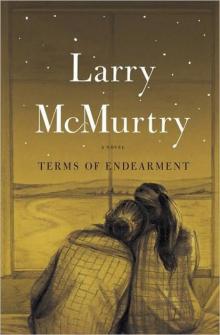 Terms of Endearment
Terms of Endearment Some Can Whistle
Some Can Whistle All My Friends Are Going to Be Strangers
All My Friends Are Going to Be Strangers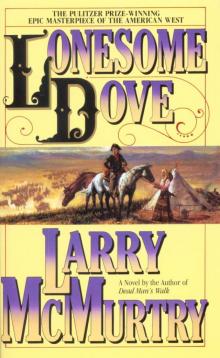 Lonesome Dove
Lonesome Dove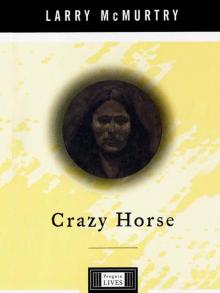 Crazy Horse: A Life
Crazy Horse: A Life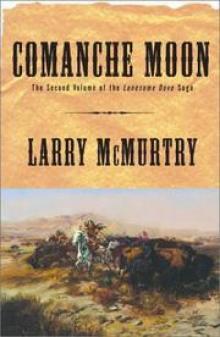 Comanche Moon
Comanche Moon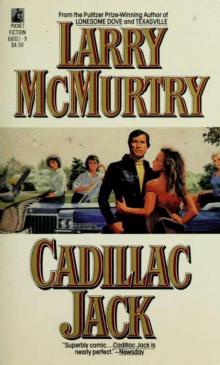 Cadillac Jack
Cadillac Jack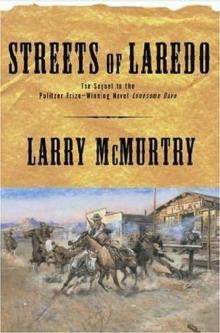 Streets of Laredo
Streets of Laredo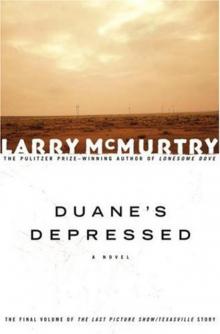 Duane's Depressed
Duane's Depressed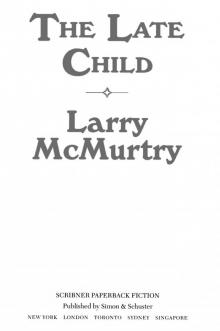 The Late Child
The Late Child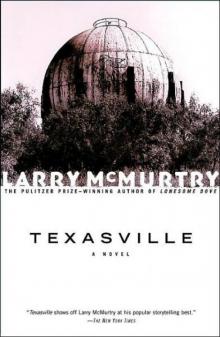 Texasville
Texasville Rhino Ranch
Rhino Ranch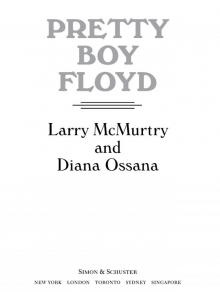 Pretty Boy Floyd
Pretty Boy Floyd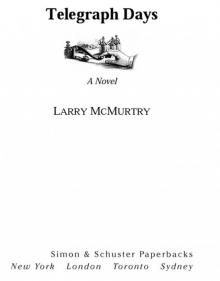 Telegraph Days
Telegraph Days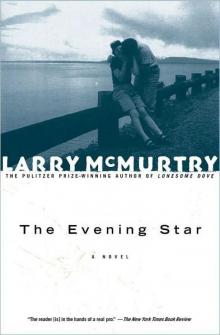 The Evening Star
The Evening Star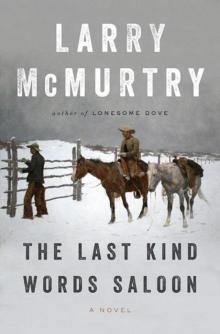 The Last Kind Words Saloon
The Last Kind Words Saloon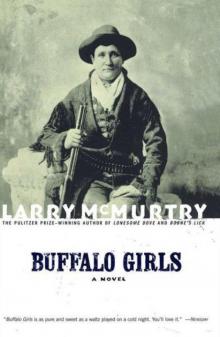 Buffalo Girls
Buffalo Girls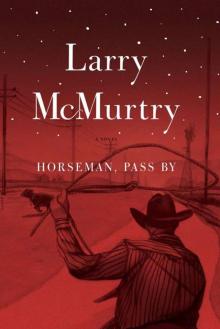 Horseman, Pass By
Horseman, Pass By Boone's Lick
Boone's Lick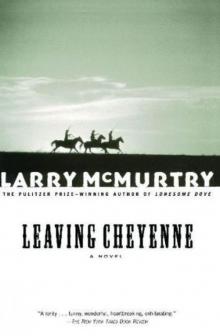 Leaving Cheyenne
Leaving Cheyenne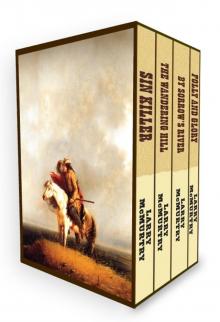 Sin Killer
Sin Killer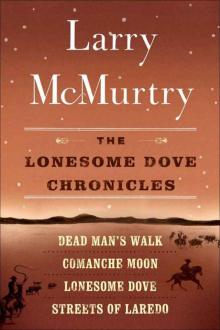 The Lonesome Dove Chronicles (1-4)
The Lonesome Dove Chronicles (1-4)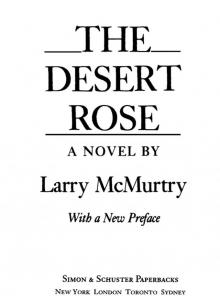 The Desert Rose
The Desert Rose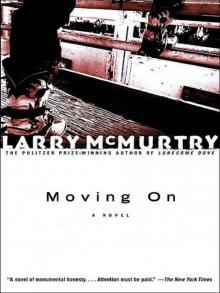 Moving On
Moving On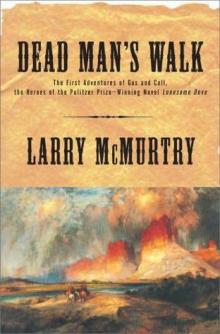 Dead Man's Walk
Dead Man's Walk The Last Picture Show
The Last Picture Show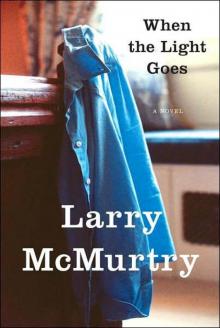 When the Light Goes
When the Light Goes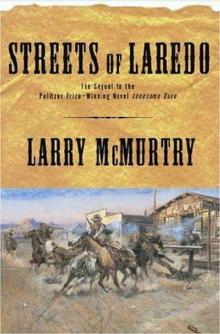 Streets Of Laredo ld-2
Streets Of Laredo ld-2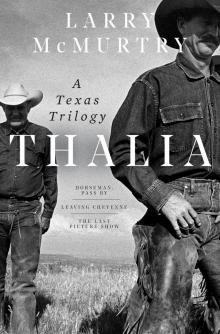 Thalia
Thalia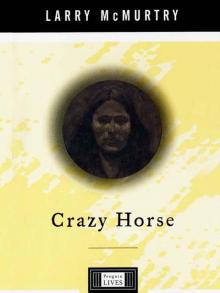 Crazy Horse
Crazy Horse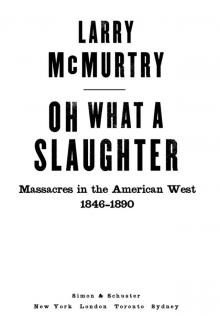 Oh What a Slaughter
Oh What a Slaughter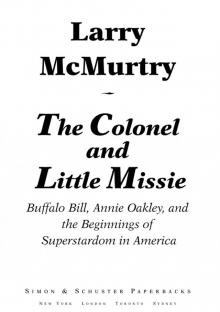 The Colonel and Little Missie
The Colonel and Little Missie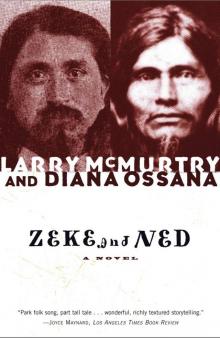 Zeke and Ned
Zeke and Ned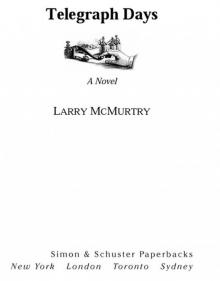 Telegraph Days: A Novel
Telegraph Days: A Novel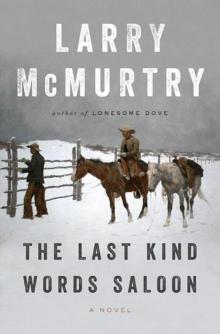 The Last Kind Words Saloon: A Novel
The Last Kind Words Saloon: A Novel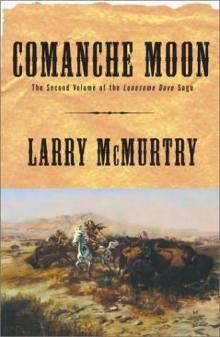 Comanche Moon ld-4
Comanche Moon ld-4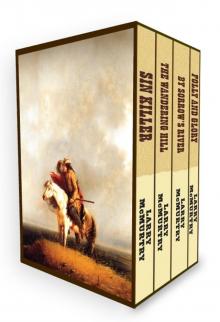 The Berrybender Narratives
The Berrybender Narratives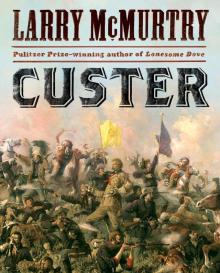 Custer
Custer